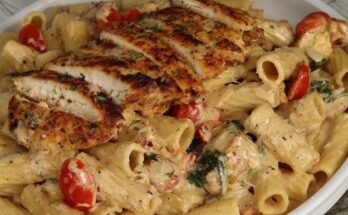Burrata Cheese Recipe: Ever sliced into a soft, white ball of cheese and watched a rich, creamy center spill out like a delicious surprise? That’s burrata—a luxurious Italian cheese that feels like the best-kept secret in gourmet kitchens. Burrata is essentially mozzarella with a twist. The outside is a delicate pouch of mozzarella, while the inside is filled with a luscious mixture of stracciatella (shredded cheese curds) and cream. The moment you try it, you’re hooked.
So, why make burrata at home when you can buy it at a store? First, homemade always tastes better—it’s fresher, creamier, and made with love. Plus, if you’re into experimenting in the kitchen, crafting burrata from scratch is surprisingly doable and incredibly rewarding. Think of it like baking bread or fermenting your own pickles. There’s something magical about creating this delicate, restaurant-level cheese with your own hands.
Whether you’re a foodie looking to impress dinner guests or just curious about the art of cheesemaking, this guide will walk you through everything—step-by-step. Let’s dive into the cheesy goodness.
Ingredients Needed for Homemade Burrata
You don’t need a fancy cheese cave or exotic supplies to make burrata at home. Most ingredients can be found online or at specialty grocery stores. Let’s break it down.
Fresh Ingredients Breakdown:
- Whole Milk (1 gallon): Make sure it’s not ultra-pasteurized. Raw or low-temperature pasteurized milk works best.
- Heavy Cream (1 cup): For that rich, creamy filling.
- Citric Acid (1 ½ teaspoons): Helps curdle the milk to form cheese curds.
- Liquid Rennet (¼ teaspoon diluted in ¼ cup of water): This is essential for coagulating the milk.
- Cheese Salt (1 teaspoon or to taste): Adds flavor without interfering with the bacteria or texture.
- Filtered Water: For dissolving citric acid and rennet.
Tools and Equipment You’ll Need:
- Large stockpot (stainless steel preferred)
- Cooking thermometer (essential for precise temperatures)
- Slotted spoon or ladle
- Cheesecloth or muslin
- Two mixing bowls (for curds and cream filling)
- Colander
- Knife for cutting curds
- A bowl of ice water (for shocking the cheese at the end)
Pro tip: Clean and sanitize everything before you begin. This isn’t just for hygiene—it helps avoid weird flavors or failed textures.
Step-by-Step Guide to Making Burrata Cheese
Now we’re getting to the heart of the matter. The process of making burrata isn’t complicated, but it does require attention to detail. Don’t worry—I’ve broken it down so even first-timers can nail it.
Step 1: Preparing the Milk Mixture
Pour the whole milk into your large stockpot. Over medium heat, slowly warm it up to 90°F (32°C). Stir gently every few minutes to make sure it heats evenly.
Once it hits the right temperature, dissolve the citric acid in ¼ cup of filtered water and stir it into the milk. This step helps acidify the milk, making it easier to form curds later.
After that, take your liquid rennet and dilute it in another ¼ cup of water. Pour this mixture gently into the milk while stirring in an up-and-down motion for about 30 seconds. Then, stop stirring completely and let it sit undisturbed for 5–10 minutes. You’re waiting for the milk to set into a custard-like consistency.
You’ll know it’s ready when you can press a clean finger into the surface and it breaks cleanly (this is called a “clean break”). If it’s still runny, wait a bit longer.
Step 2: Heating and Adding Rennet
This step is where things start to feel like alchemy. After achieving a clean break, use a long knife to cut the curd into 1-inch cubes. Make vertical and horizontal cuts throughout the curd mass.
Next, slowly reheat the mixture to 105°F (40°C) over the course of 10 minutes. Stir gently and occasionally to keep the curds from clumping too much.
Once at temperature, continue to stir for a few more minutes while the curds firm up. Then, turn off the heat and let the curds sit for 5 minutes to settle.
Now it’s time to separate the curds from the whey. Using a slotted spoon, gently lift the curds into a colander lined with cheesecloth. Let them drain for about 10 minutes. Save some of the whey—you’ll need it later for stretching.
Step 3: Cutting the Curd
At this point, your curds should look soft, pillowy, and moist but not dripping. The texture is super important. You want them pliable enough to stretch later, but firm enough to hold their shape.
Meanwhile, heat a separate pot of water (or the whey you saved) to 175°F (79°C). This is your hot bath for stretching the mozzarella. It’s hot, so be careful!
Using gloves or slotted spoons, take a handful of curds and dip them into the hot whey or water. Let them soften for about 30 seconds to 1 minute, then lift and stretch gently like taffy. If they tear, give them more time to heat. Stretch a few times until they become glossy and elastic.
This is how you make the outer mozzarella shell for your burrata.
Step 4: Draining and Stretching the Curds
Here’s where you get creative. Take one portion of stretched mozzarella and flatten it into a disk about 4–5 inches across. Think of it like a small tortilla.
In a separate bowl, mix shredded mozzarella curds (or leftover pieces from earlier) with heavy cream. This is your stracciatella filling. It should be gooey, rich, and slightly salty.
Place a spoonful of this creamy filling in the center of your mozzarella disk. Then, quickly fold the edges over to seal it up like a pouch. Pinch and twist the top to close it tight. If you mess up, don’t worry—just reheat and stretch again.
Once sealed, dip your burrata into the ice bath to firm it up. This step locks everything in and keeps the shape perfect.
Step 5: Creating the Burrata Pouch and Filling
This final step is oddly satisfying. After your burrata balls are sealed and cooled, they’re ready to enjoy!
You can eat them right away while still warm and gooey, or store them in a brine or cream bath in the fridge. Either way, slice it open, watch that creamy center ooze out, and prepare for cheese nirvana.
You did it—you just made burrata from scratch.
Pro Tips for the Perfect Burrata
Mastering burrata might feel like chasing a dream the first time, but once you’ve done it, the next batch gets easier—and tastier. To help you skip the rookie mistakes, here are some expert-backed tips that can level up your cheese game.
Use the Right Milk: The foundation of great burrata is quality milk. Always go for whole milk that’s non-ultra-pasteurized. Ultra-pasteurization kills the enzymes needed for curdling, leaving you with a soupy mess. If possible, use local, organic milk, or even raw milk if it’s legally available where you live.
Handle Curds Gently: Don’t be rough with your curds. Stirring or pressing them too aggressively can ruin the texture. Think of them like delicate marshmallows—treat them with kindness. When draining, let gravity do the work instead of squeezing or pressing them.
Timing is Everything: Cheese-making is all about temperature and time. A thermometer is your best friend here. If your milk isn’t the right temperature, or if your rennet sits too long, the curds won’t form correctly. Precision ensures success.
Stretch Curds While They’re Hot: Curds only stretch properly when they’re warm. Work in small batches and keep your water or whey hot (around 175°F). If they cool down, reheat them briefly—but don’t overdo it, or they’ll get rubbery.
Seal Burrata Fast: When you’re shaping the burrata, act quickly. Once the outer shell cools, it won’t seal properly, and the filling will leak out. Practice makes perfect, so don’t worry if your first one looks a little wonky.
Flavor is Personal: Cheese salt is optional, but highly recommended. It enhances flavor without messing with fermentation. Want to get creative? Add herbs, truffle oil, or roasted garlic to the cream filling for a gourmet twist.
Serving Suggestions and Pairings
So, you’ve made your own burrata. Now what? It’s time to show it off—and trust me, burrata is the diva of the cheese world. With that creamy center and velvety texture, it turns any dish into an Instagram-worthy plate.
Classic Burrata and Tomato Salad: This is the go-to. Pair your burrata with heirloom tomatoes, a drizzle of olive oil, fresh basil, and a sprinkle of sea salt. Add a crack of black pepper and a splash of balsamic vinegar for a tangy kick.
On Toast: Toasted sourdough + burrata + honey + crushed pistachios = pure heaven. Want something savory? Top it with roasted cherry tomatoes or caramelized onions.
On Pizza: Add burrata after the pizza comes out of the oven. It melts gently and creates a creamy contrast to crispy crusts and bold toppings like prosciutto, arugula, or spicy sausage.
As a Pasta Topper: Ever tried warm pasta tossed in garlic butter with burrata on top? The cheese melts slightly into the pasta, creating a rich, creamy sauce. It’s comfort food at its finest.
Wine Pairings: Burrata’s richness pairs well with crisp white wines like Sauvignon Blanc or Pinot Grigio. For red lovers, a light-bodied red like Pinot Noir balances things beautifully.
Bread Pairings: Serve with crusty baguette, focaccia, or even grilled flatbread. Burrata loves a good carb.
Storage and Shelf Life
Homemade burrata isn’t made to last forever—but that’s okay, because it’s so delicious you probably won’t have leftovers. Still, here’s how to store it like a pro.
Refrigeration: Place your burrata in a sealed container filled with a bit of whey or salted water to keep it moist. You can also use a mixture of cream and milk if you want to mimic the original flavor. Store in the fridge for up to 3 days. After that, it starts losing its texture and flavor.
Avoid Freezing: Burrata does not freeze well. The creamy interior becomes grainy, and the mozzarella shell gets rubbery. Eat it fresh—it’s a cheese made to be savored right away.
Serving from the Fridge: Let it sit at room temperature for 30 minutes before serving. This helps the center become creamy again and brings out the full flavor.
Signs It’s Gone Bad: If the cheese smells sour or has a slimy texture, toss it. Fresh burrata should smell like milk and taste slightly sweet.
FAQs about Burrata Cheese Recipe
What is burrata cheese made of?
Burrata is made from fresh mozzarella and cream. The outer shell is solid mozzarella, while the inside contains stracciatella and cream, making it rich, soft, and ultra-creamy.
Can I make burrata cheese at home?
Yes! While it takes a bit of practice, you can make burrata at home using cow’s milk, rennet, and cream. A mozzarella-making kit helps speed things up.
How long does homemade burrata last?
Fresh burrata is best enjoyed within 1–2 days. Store it in the fridge, submerged in brine or whey, for maximum freshness.
What can I serve with burrata cheese?
Think tomatoes, prosciutto, grilled peaches, crusty bread, olive oil, or even pasta. Burrata pairs well with both savory and sweet ingredients.
Can I freeze burrata cheese?
Nope—freezing ruins its delicate texture. Burrata is a “live in the moment” kind of cheese—enjoy it fresh!
Is burrata the same as mozzarella?
Not quite. While burrata contains mozzarella, it’s a level-up experience with a creamy center that mozzarella alone doesn’t offer.
Conclusion
And there you have it—a complete, step-by-step guide to making homemade burrata cheese. What started as simple milk has transformed into a gourmet delicacy right in your kitchen. Whether you’re hosting a dinner party, prepping an appetizer board, or just treating yourself, burrata adds a touch of magic to any meal.
The process may seem a bit involved, but once you get the hang of it, making burrata becomes almost therapeutic. From the moment you stretch the curds to when you slice into that creamy center, it’s pure culinary satisfaction.
So, roll up your sleeves, grab your thermometer, and let the cheese-making begin. Trust me, your taste buds (and your friends) will thank you.



